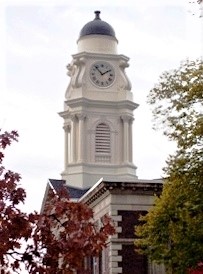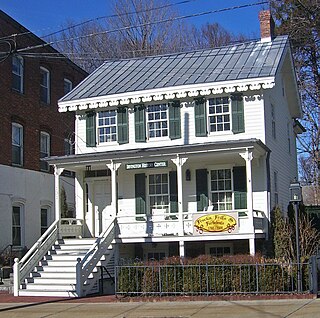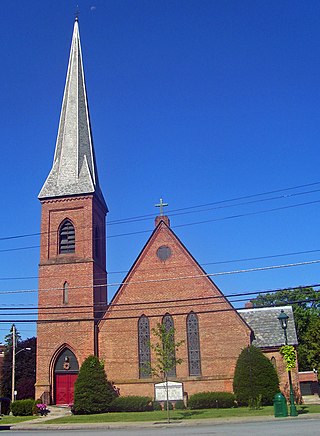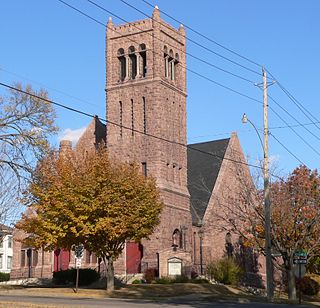
Irvington, sometimes known as Irvington-on-Hudson, is a suburban village in the town of Greenburgh in Westchester County, New York, United States. It is located on the eastern bank of the Hudson River, 20 miles (32 km) north of midtown Manhattan in New York City, and is served by a station stop on the Metro-North Hudson Line. To the north of Irvington is the village of Tarrytown, to the south the village of Dobbs Ferry, and to the east unincorporated parts of Greenburgh, including East Irvington. Irvington includes within its boundaries the community of Ardsley-on-Hudson, which has its own ZIP code and Metro-North station, but which should not be confused with the nearby village of Ardsley.

Christ Episcopal Church is a historic Episcopal church located at 43 South Broadway in Tarrytown, New York. Topped by a modest tower, the ivy-covered red brick church was built in 1837 and maintains an active congregation to the present day. The church also includes the San Marcos Mission, a Spanish-language ministry.

St. Michael's Church is a historic Episcopal church at 225 West 99th Street and Amsterdam Avenue on Manhattan's Upper West Side in New York City. The parish was founded on the present site in January 1807, at that time in the rural Bloomingdale District. The present limestone Romanesque building, the third on the site, was built in 1890–91 to designs by Robert W. Gibson and added to the National Register of Historic Places in 1996.

St. Peter's Episcopal Church, also known as St. Peter's Church, is located in downtown Albany, New York, United States. It was designed in the mid-19th century by Richard Upjohn and his son Richard M. Upjohn in the French Gothic Revival architectural style. It was listed on the National Register of Historic Places in 1972, and designated a National Historic Landmark eight years later. It is also a contributing property to the Downtown Albany Historic District.

St. Philip's Church in the Highlands is an Episcopal church located on New York State Route 9D in the hamlet of Garrison, New York, United States, within the town of Philipstown in the Hudson Highlands. It is a stone Gothic Revival building designed by Richard Upjohn, a congregant of the church, opened in 1865.

St. John's Episcopal Church is an antebellum-era church located at 2326 Woodward Avenue in Downtown Detroit, Michigan. It is the oldest church still standing on Woodward Avenue, an area once called Piety Hill for its large number of religious buildings. The church was listed on the National Register of Historic Places in 1982 and designated a Michigan State Historic Site in 1987.

The McVickar House is located at 131 Main Street in Irvington, New York, United States. It is a wooden frame house built in the middle of the 19th century in the Greek Revival architectural style with some Picturesque decorative touches added later. In 2004 it was listed on the National Register of Historic Places.

Zion Memorial Chapel, now known as St. Nicholas-on-the-Hudson, is an historic Carpenter Gothic style Episcopal church building located at 37 Point Street in New Hamburg, New York, United States. It was built in 1902 as a chapel of nearby Zion Church in Wappingers Falls and became a separate parish in 1983.

St. Luke's Episcopal Church is located in Beacon, New York, United States. The church complex of four buildings and a cemetery takes up a 12-acre (4.9 ha) parcel between Wolcott, Rector, Phillips and Union Streets. It was founded in 1832 as a religious school that soon became St. Anna's Church of Fishkill Landing.

St. Andrew's Episcopal Church is located at the corner of Walnut and Orchard Street in the village of Walden, New York, United States. It is a brick Gothic Revival structure designed and built in 1871 by Charles Babcock, a former partner of Richard Upjohn. Located at the center of town, near the village hall, it is a local landmark that dominates the village's skyline.

Saint Paul's Church, Chapel, and Parish House are a historic Episcopal Church complex at 15 and 27 Saint Paul Street and 104 Aspinwall Avenue in Brookline, Massachusetts. The Gothic Revival church building was designed by Richard Upjohn and built in 1851-52, and is the oldest surviving religious building in the town. The complex was listed on the National Register of Historic Places in 1985.
St. Barnabas Episcopal Church, later called Christ & St. Barnabas Episcopal Church, and now known as New Hope Missionary Baptist Church, is an historic Episcopal church and rectory at 2900 Fifth Avenue in Troy, Rensselaer County, New York. The church was built in 1895 and is a red brick church in the Late Gothic Revival style. It has a gable roof and three hipped dormers. It has an open bell tower and slender conical turrets. It features a rose window depicting the Madonna and Child. The former rectory is a 2+1⁄2-story, L-shaped brick residence. Also on the property is a contributing carved stone crucifixion dated to about 1900.

St. Michael's Episcopal Church, Parish House and Rectory is a group of architecturally-significant religious buildings located at 200-216 North Mill Street in Birdsboro, Berks County, Pennsylvania. It was added to the U.S. National Register of Historic Places in 1982.

St. John's Episcopal Church is a parish church in the Episcopal Diocese of Iowa. It is located in Keokuk, Iowa, United States. It was listed, together with the parish hall, on the National Register of Historic Places in 1989.

St. Thomas Episcopal Church is a parish church in the Episcopal Diocese of Iowa. The church is located in Sioux City, Iowa, United States. The church building was listed on the National Register of Historic Places in 1984.

St. Katherine's Historic District is located on the east side Davenport, Iowa, United States and is listed on the National Register of Historic Places. It is the location of two mansions built by two lumber barons until it became the campus of an Episcopal girls' school named St. Katharine's Hall and later as St. Katharine's School. The name was altered to St. Katharine-St. Mark's School when it became coeducational. It is currently the location of a senior living facility called St. Katherine's Living Center.

St. Andrew's Episcopal Church is located at North Main and Madison avenues in Albany, New York, United States. It is a complex of three buildings, centered on the church itself, a stone structure designed by architect Norman Sturgis in the Late Gothic Revival architectural style and built in 1930. In 2005 it was listed on the National Register of Historic Places.

St. Luke's Episcopal Church, Chapel, Guildhall, and Rectory is a historic church complex in Racine, Wisconsin. It was added to the National Register of Historic Places in 1979 for its architectural significance.

St. Paul's Episcopal Church is a historic parish of the Episcopal Church in Watertown, Wisconsin,. Its buildings display different phases of Gothic Revival architecture, and in 1979 the complex was added to the National Register of Historic Places for its architectural significance.

St. John's Episcopal Church is a historic church at 768 Fairfield Avenue in Bridgeport, Connecticut. Built in 1873 for a congregation founded in the mid-18th century, it is a well-preserved design of James Renwick Jr. and a good example of late 19th-century Gothic Revival archiecture. It was listed on the National Register in 1984.






















